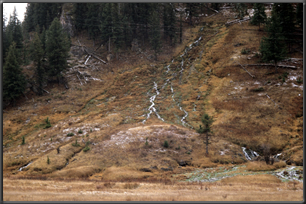Slopes
 Slope wetlands are found in association with the discharge of groundwater to the land surface or sites with saturated overflow with no channel formation. They normally occur on sloping land ranging from slight to steep. The predominant source of water is groundwater or interflow discharging at the land surface. Precipitation is often a secondary contributing source of water. Hydrodynamics are dominated by downslope unidirectional water flow. Slope wetlands can occur in nearly flat landscapes if groundwater discharge is a dominant source to the wetland surface. Slope wetlands lose water primarily by saturated subsurface flows, and by evapotranspiration. Slope wetlands may develop channels, but the channels serve only to convey water away from the slope wetland. Slope wetlands are distinguished from depressional wetlands by the lack of a closed topographic depression and the predominance of the groundwater/interflow water source. Fens are a common example of slope wetlands.
Slope wetlands are found in association with the discharge of groundwater to the land surface or sites with saturated overflow with no channel formation. They normally occur on sloping land ranging from slight to steep. The predominant source of water is groundwater or interflow discharging at the land surface. Precipitation is often a secondary contributing source of water. Hydrodynamics are dominated by downslope unidirectional water flow. Slope wetlands can occur in nearly flat landscapes if groundwater discharge is a dominant source to the wetland surface. Slope wetlands lose water primarily by saturated subsurface flows, and by evapotranspiration. Slope wetlands may develop channels, but the channels serve only to convey water away from the slope wetland. Slope wetlands are distinguished from depressional wetlands by the lack of a closed topographic depression and the predominance of the groundwater/interflow water source. Fens are a common example of slope wetlands.
Example Subclasses

Back to HGM Approach
Web Date: October 1997
Updated: February 2022
|

